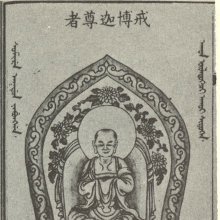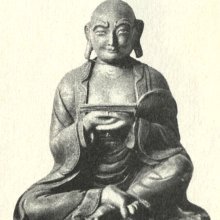Gopaka: 10 definitions
Introduction:
Gopaka means something in Hinduism, Sanskrit, Buddhism, Pali. If you want to know the exact meaning, history, etymology or English translation of this term then check out the descriptions on this page. Add your comment or reference to a book if you want to contribute to this summary article.
Images (photo gallery)
In Hinduism
Kavya (poetry)
Source: Wisdom Library: KathāsaritsāgaraGopaka (गोपक) is the name of a warrior slain by Kālakampana, according to Kathāsaritsāgara, chapter 47. His name is found in “the story of Sūryaprabha and how he attained Sovereignty over the Vidyādharas” told by king Vajraprabha to Naravāhanadatta.
The Kathāsaritsāgara (‘ocean of streams of story’), mentioning Gopaka, is a famous Sanskrit epic story revolving around prince Naravāhanadatta and his quest to become the emperor of the vidyādharas (celestial beings). The work is said to have been an adaptation of Guṇāḍhya’s Bṛhatkathā consisting of 100,000 verses, which in turn is part of a larger work containing 700,000 verses.

Kavya (काव्य, kavya) refers to Sanskrit poetry, a popular ancient Indian tradition of literature. There have been many Sanskrit poets over the ages, hailing from ancient India and beyond. This topic includes mahakavya, or ‘epic poetry’ and natya, or ‘dramatic poetry’.
Languages of India and abroad
Pali-English dictionary
Source: BuddhaSasana: Concise Pali-English Dictionarygopaka : (m.) a guardian; watch-man.
Source: Sutta: The Pali Text Society's Pali-English DictionaryGopaka, a guardian, watchman DA.I, 148; cp. khetta°. (Page 255)

Pali is the language of the Tipiṭaka, which is the sacred canon of Theravāda Buddhism and contains much of the Buddha’s speech. Closeley related to Sanskrit, both languages are used interchangeably between religions.
Sanskrit dictionary
Source: Cologne Digital Sanskrit Dictionaries: Edgerton Buddhist Hybrid Sanskrit DictionaryGopaka (गोपक).—name of a disciple of Buddha: Karmavibhaṅga (and Karmavibhaṅgopadeśa) 65.7. Perhaps the same as Pali āyasmā Gopako, Vin. i.300.5.
Source: Cologne Digital Sanskrit Dictionaries: Shabda-Sagara Sanskrit-English DictionaryGopaka (गोपक).—mfn.
(-kaḥ-kā-kaṃ) One who guards or protects. m.
(-kaḥ) 1. Myrrh. 2. The Superintendent of a district. E. kan added to the preceding.
Source: Cologne Digital Sanskrit Dictionaries: Monier-Williams Sanskrit-English Dictionary1) Gopaka (गोपक):—[from go-pa] m. ([gana] yājakādi, [Gaṇaratna-mahodadhi 99 [Scholiast or Commentator]]) a cowherd, [Dhūrtanartaka]
2) [v.s. ...] ([from] gopaya) guardian (ifc.) See cīvara-
3) [v.s. ...] the superintendent of a district, [cf. Lexicographers, esp. such as amarasiṃha, halāyudha, hemacandra, etc.]
4) [v.s. ...] myrrh, [cf. Lexicographers, esp. such as amarasiṃha, halāyudha, hemacandra, etc.]
Source: Cologne Digital Sanskrit Dictionaries: Yates Sanskrit-English DictionaryGopaka (गोपक):—(kaḥ) 1. m. Myrrh. a. Keeping.
Source: DDSA: Paia-sadda-mahannavo; a comprehensive Prakrit Hindi dictionary (S)Gopaka (गोपक) in the Sanskrit language is related to the Prakrit word: Govaya.
[Sanskrit to German]
Sanskrit, also spelled संस्कृतम् (saṃskṛtam), is an ancient language of India commonly seen as the grandmother of the Indo-European language family (even English!). Closely allied with Prakrit and Pali, Sanskrit is more exhaustive in both grammar and terms and has the most extensive collection of literature in the world, greatly surpassing its sister-languages Greek and Latin.
See also (Relevant definitions)
Starts with: Gopaka-moggallana, Gopaka-sivali, Gopakanu, Gopakanya, Gopakanyaka, Gopakarkati, Gopakarkatika.
Ends with: Assagopaka, Bhandagopaka, Chivaragopaka, Civaragopaka, Harigopaka, Hatthigopaka, Indagopaka, Indragopaka, Khettagopaka, Kriyagopaka, Pratigopaka, Sakata-gopaka, Samgopaka, Shakragopaka, Susanagopaka, Tridashagopaka, Varshashatigopaka.
Full-text (+4): Gopika, Govaya, Harigopaka, Bhandagopaka, Indragopa, Varshashati, Sakata-gopaka, Tridashagopaka, Tridashagopa, Shakragopaka, Hatthigopaka, Khettagopaka, Susanagopaka, Varshashatigopaka, Indragopaka, Indagopaka, Kanaverapupphiya, Upananda, Candadatta, Prashasta.
Relevant text
Search found 14 books and stories containing Gopaka; (plurals include: Gopakas). You can also click to the full overview containing English textual excerpts. Below are direct links for the most relevant articles:
Cidgaganacandrika (study) (by S. Mahalakshmi)
Verse 157 [Svaracatuṣṭaya governs Jagatkrama] < [Chapter 3 - Third Vimarśa]
The Great Chronicle of Buddhas (by Ven. Mingun Sayadaw)
The Story of Deva Gopaka < [Chapter 39 - How the Āṭānāṭiya Paritta came to be Taught]
Part 2 - The Buddha’s Discourse to Sakka (Sakka Pañha Sutta) < [Chapter 39 - How the Āṭānāṭiya Paritta came to be Taught]
The Story of Magha, the Young Man of Macala Village < [Chapter 39 - How the Āṭānāṭiya Paritta came to be Taught]
Vinaya Pitaka (3): Khandhaka (by I. B. Horner)
The story of a eunuch < [1. Going forth (Pabbajjā)]
On when a robe becomes the Saṅgha’s < [8. Robes (Cīvara)]
Bihar and Eastern Uttar Pradesh (early history) (by Prakash Narayan)
Empirical Relevance of Vanna, Jati and Kula < [Chapter 4 - Social Process, Structures and Reformations]
Agriculture and Cattle-keeping < [Chapter 2 - Economic and Urban Processes]
Fundamentals of Vipassana Meditation (by Venerable Mahāsi Sayādaw)
The Padma Purana (by N.A. Deshpande)
Chapter 133 - The Holy Places in Jambūdvipa < [Section 6 - Uttara-Khaṇḍa (Concluding Section)]
Related products

